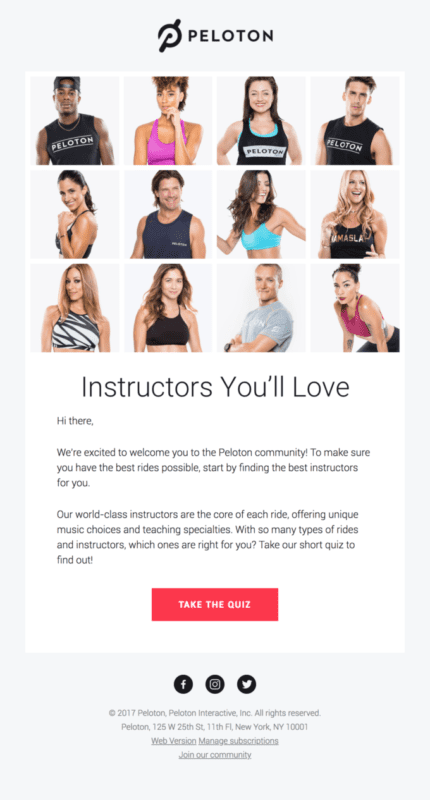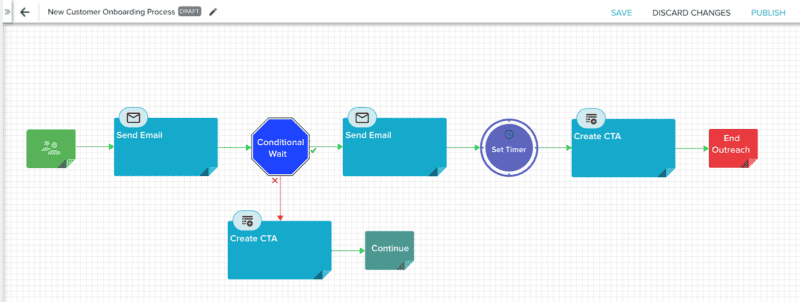Ignoring the haters! It’s indisputable that Peloton — and other digital fitness companies like it — have changed the way millions of human beings exercise.

Sure, the latest Sex and the City reboot and stock price drop aren’t great for business. But as a Peloton rider myself, I have seen first-hand how Peloton has transformed the fitness industry. (Yes, I fit the CEO tech nerd stereotype to a tee.) Whether I choose to ride with the inspirational Robin Arzon or the hilarious Cody Rigsby, Peloton has revolutionized my personal fitness. And it’s also changed my perspective in terms of how I think about Customer Success.
Here’s why.
Scaling Fitness

How did people work out before companies like Peloton were around? It seemed like there were only two routes. On the one hand, you had the highly self-motivated people who woke up at 5 AM and headed straight to the gym to plan their personal workouts. And the rest of us who were sleeping in thought, “how annoying!” They didn’t need a coach or any nudges – they seized the day, every day.
On the other hand, you had the person with the flexibility and resources to hire a personal trainer. Their trainer would coach them and design a workout routine for their body, lifestyle, and goals – and motivate them to keep it up every week.
And, as Peloton observed, there were millions of people who didn’t fit neatly into either of these categories:
- People who wanted to exercise but needed a nudge of encouragement.
- People who wanted to be instructed but didn’t have the time or resources for one-on-one training.
- People who wanted to work out in the comfort of their home, but didn’t want to feel alone.
In many ways, Customer Success has grown up out of the same dichotomy. In the older business model, you had two types of clients. You had your larger clients that you would do anything for, including customizing your software for them. You would be like their personal “software” trainer. And then you had your smaller clients. Whether they were motivated enough to “go to the gym” (in the form of using your software) or not, they still had paid you, so all was good.
Modern, scalable Customer Success is about using process and technology to find a new way — a better way.
1. Peloton Uses A One-To-Many “Fitness Success” Model

Peloton has the best “CSMs” (or should I say Fitness Success Managers?) in the world. They are experts in their field. They are inspirational. They motivate you. They are entertaining. You couldn’t imagine better personal trainers. And for most of us, we could never access them one-on-one.
But Peloton figured out how to scale their personal trainers to millions of people. The hardware – the connected bike with a nice screen – is a commodity. Peloton created a software platform – with personalization, choice (90s music is my main way to select rides), scheduling, and more – to connect the right “Fitness Success Manager” to their clients.
Similarly, modern Customer Success is no longer just about “high touch” CSMs for your largest clients. Nearly every SaaS company is creating a “scaled” or “digital” Customer Success initiative, combining multiple strategies including:
- Automating routine tasks like reporting, Quarterly Business Review decks, emails, and more to allow CSMs to cover more clients.
- Creating a “virtual CSM” through a digital-first journey based upon customer behavior.
- In some cases, creating “pooled” CSM teams that aren’t assigned to clients but instead, intervene based upon triggers of risk or opportunity.
2. Peloton Creates Personalized Product Experiences

The geniuses behind Peloton realize that people don’t always do what they want – sometimes, you have to nudge and encourage them. But the instructors can’t, themselves, communicate with every rider one-on-one.

So instead, Peloton uses the power of personalization to drive people to the behaviors they need to achieve their goals — like noticing when you hit “milestone” rides (my next big one is my 1,000th!) and recommending rides based upon your past interests (hence, the constant promotions I get for the Taylor Swift Artist Series). Peloton tracks all of your habits and uses this data to ensure you continue to improve and engage with the platform.
Nearly every SaaS business is adopting a similar approach through Product Experience to deliver scalable Customer Success. This includes utilizing in-app guides to onboard new customers, walkthroughs to help clients try out new features, and surveys to get feedback from customers as they work. All of this is built to improve and personalize the experience based upon the user’s behavioral data.

3. Peloton Created a Community

Most Peloton riders have had a weird experience similar to those I have daily. It’s 6:30 AM, and I’m on my bike in the living room. I’ve got my AirPods in and am cranking away to Robin Arzon’s Broadway ride. I’m singing and dancing along with the group. And every now and then, one of my kids walks by, looks at me, cringes, and then walks away.
The point is that with Peloton, you might be physically alone, but you don’t feel that way. You can join hashtag groups (we have one at Gainsight – #pelotongainsters), compete on leaderboards, give each other “high fives,” and much more. It creates this feeling like you are riding alongside so many other people. Indeed, that’s what the word “peloton” means by definition.
It is no different in Customer Success – I recently wrote a blog about the past, present, and future of Customer Success and how CS wouldn’t be where we are today without our community. Customer Success was built on community. It is part of our past, present, and will be part of the future. What started as a mere idea – cooked up in a small office in Mountain View, CA, above a bar – to bring together 300 CSMs for the first-ever Pulse event, turned into over hundreds of thousands of CS professionals getting together annually to network and learn from each other.
It’s never been more important to create a space for your clients to discuss product ideation, increase feedback loops, share resources, and become advocates. We know because our Gamechanger Community helps our clients to feel more connected. And our top clients reported that 57% currently use a community platform, and an additional 24% are planning to implement a community platform this year.
The Future of Customer Success and Community
Peloton helped bring fitness to millions of people using a one-to-many model, personalized product experience, and immersive community. Now, it’s time for Customer Success teams to embrace these three key plays to help scale CS. Putting our money where our mouth is, this is why we acquired SaaS Community Software leader inSided. Next up, time for us to see if Cody Rigsby is interested in a career in Customer Success!



